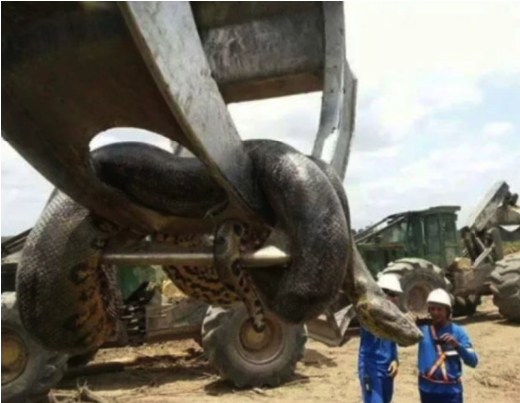Nature often holds surprises for those who take the time to wander its trails, and sometimes those surprises are so extraordinary they leave an impression that lasts forever. That is exactly what happened to hiker Meredith Langley during a visit to Jeffries Creek Park in Florence, South Carolina. What began as a peaceful walk turned into an unforgettable encounter when she spotted a colossal snake resting near the creek, blending almost perfectly into its surroundings. Far from being a moment of panic, it became an experience that highlighted both the beauty of the natural world and the importance of respecting it.

Langley, who often hikes the area with her children, shared the discovery with members of a South Carolina hiking club on social media. Her post quickly sparked curiosity, admiration, and discussions about trail safety and wildlife awareness. She explained how the snake’s impressive camouflage made it nearly invisible against the earthy tones of the park. For her children, who tend to forget trail etiquette in their excitement to run ahead, it served as a perfect teaching moment. “It was a good teaching opportunity and example for my own children who forget not to overtake on the trails,” she wrote, emphasizing the importance of patience and attentiveness in nature.
Experts quickly weighed in on the discovery. Greg Lucas, a representative of the South Carolina Department of Natural Resources, identified the animal as a non-venomous brown water snake from the Nerodia genus. While these snakes often appear larger than they are due to their thick, muscular bodies, Lucas noted they typically grow to between thirty and sixty inches in length. For those unfamiliar with snakes, their appearance can be intimidating, but brown water snakes play an important role in the ecosystem and pose no threat to people if left undisturbed.
Langley herself estimated the snake she encountered to be about four feet long when fully stretched out. Despite its size, she explained that the snake did not react aggressively or fearfully to her presence. Instead, it simply observed her and her children from a calm, almost aloof stance. “It wasn’t afraid of us at all,” she noted. To her, its demeanor reflected confidence rather than hostility—a quiet assurance that it was capable of defending itself if necessary, but had no need to waste energy doing so.
For Langley, the experience was less about fear and more about reverence. She described feeling grateful for the opportunity to witness such a magnificent creature in its own environment. After observing the snake respectfully, she and her children continued their hike, leaving the animal undisturbed. “This area is her home, not ours,” Langley reflected, adding that she and her children always strive to maintain respect and reverence whenever they are outdoors. Her words echoed a philosophy of coexistence, one that values the balance between humans and the wildlife that share our spaces.
Jeffries Creek Park, where the encounter took place, is known for its scenic beauty and rich biodiversity. The area is home to a wide range of reptiles, including water snakes and water moccasins. For hikers like Langley, spotting snakes is not uncommon, yet every sighting carries a unique lesson. By bringing her children on weekly hikes, she hopes to instill in them an appreciation for the outdoors and a respect for the creatures that inhabit it. Rather than teaching them to fear snakes, she teaches them to observe, understand, and tread carefully.
Encounters like these remind us that nature is not a theme park designed for human entertainment, but a living, breathing world with its own rules and rhythms. Snakes, in particular, often get a bad reputation due to fear and misunderstanding. However, most are harmless and serve essential roles in their ecosystems, from controlling rodent populations to maintaining balance among smaller wildlife species. Langley’s calm reaction and willingness to learn from the encounter provided her children with an invaluable example of how to coexist peacefully with animals that may initially seem intimidating.
The story also underscores a broader message about hiking etiquette. Trails are shared spaces, not just with other people but with the wildlife that calls them home. Moving too quickly, making unnecessary noise, or failing to watch where one steps can disrupt habitats and put both people and animals at risk. By turning the sighting into a teachable moment, Langley reminded her children—and anyone following her story online—that hiking is not simply about exercise or scenery. It is about awareness, patience, and respect for the environment.
What made Langley’s account especially inspiring was her interpretation of the snake’s behavior. Instead of projecting fear onto the animal, she saw its calmness as a sign of resilience and self-assurance. It was a reminder that strength does not always need to be displayed through aggression. Sometimes, it is simply the quiet presence of a creature in its rightful home, carrying on its life undisturbed, that leaves the strongest impression.
When she shared her experience with the hiking community, many responded with awe rather than alarm. Some praised her for teaching her children valuable lessons, while others admitted they might have reacted with fear had they been in her position. By showing that encounters with wildlife can be safe, educational, and even uplifting when handled with respect, Langley helped shift the conversation from fear to understanding.
In the peaceful setting of Jeffries Creek Park, one hiker’s chance encounter with a snake became much more than a story about a big reptile. It became a lesson in coexistence, humility, and respect for nature. For Langley, it was a moment to pass on wisdom to her children—that the outdoors is not something to be conquered or controlled, but something to be experienced with care. For the rest of us, her story is a reminder that even in unexpected encounters, we can find wonder, perspective, and respect for the delicate balance of life.





